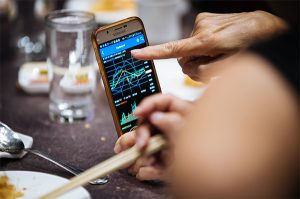Date: August 26, 2019

- The STI lost 4.68 points over the week at 3,110.35;
- Investors were initially focused on direction of US rates ahead of Friday’s speech by US Fed chair Powell;
- China’s trade retaliation on Friday and Trump’s announcement of more tariffs sent Wall St plunging;
- The US FOMC’s meeting minutes showed a Fed divided over whether to cut rates;
- The US yield curve inverted three times during the week;
- SocGen strategist thinks there’s more to come and a recession has already started.
Investors initially were unsure of what might happen next
A local broking firm in one of its daily market reports described markets as being in a “state of flux’’, which essentially means investors don’t know which way to turn because of mixed and conflicting signals.
On the one hand is the ongoing US-China trade conflict, which until Friday looked locked in a stalemate with no new developments.
For the first four days of the week, the attention was therefore on US Federal Reserve chairman Jerome Powell’s speech on Friday because as far as investors knew on the trade front, the US had delayed imposing fresh tariffs on Chinese imports until December – supposedly in order to benefit US Christmas shoppers. Markets knew that China had promised to retaliate, and that the situation could change overnight. As it turned out, this happened on Friday.
China retaliated and so did the US
On Friday, China announced levies on US$75b worth of US goods, a move that will hit US carmakers. Later that day, US President Trump announced that from Oct 1, duties on US$250b worth of China goods that were already in effect would rise from 25 to 30% and that the remaining US$300b in Chinese imports would be taxed at 15% instead of 10% starting from 1 Sep.
Wall Street on Friday plunged – the Dow Jones Industrial Average lost 623 points or 2.4% at 25,628.
The yield curve inverted again and again
On the interest rate front, the inversion of the US Treasury yield curve a week ago and again several times this week is still very much in the minds of investors, prompting an uneasy feeling throughout markets that a recession is forthcoming since this is what an inverted yield curve typically portends. Moreover, this feeling is borne out by the numbers – China and Germany have already reported rapidly slowing economies and the US’s economy is already decelerating.
On Friday the curve inverted multiple times following China’s trade announcement and Trump’s tweets that ordered US companies to stop making products in China and to start making them in the US.
Wither US interest rates?
Adding to the state of flux is the minutes of the 31 July US Federal Reserve Open Markets Committee meeting, which were released last week. They revealed that most officials saw the July 25 basis point reduction in the Fed’s main interest rate as a “recalibration of the stance of policy, or a mid-cycle adjustment, in response to the evolution of the economic outlook”.
But within that general consensus, there was a wide range of views on the Federal Open Market Committee. “A couple” of members said they would have preferred a 50bp cut in rates immediately, pointing to the need for “stronger action” against “stubbornly low inflation” whilst several others were in favour of keeping rates steady because the US economy appeared to be still doing well.
In his speech on Friday, Mr Powell said the US central bank was limited in its ability to counteract Trump’s trade policies which were stoking uncertainty and posing risks to the economic outlook. In response, Trump labelled Mr Powell an “enemy’’.
Is this a bond market bubble or is there more to come?
Many observers believe that record-low bond yields are the result of a huge bubble.
Société Générale’s permanently bearish strategist Albert Edwards begs to differ – last week he was reported as saying he thinks a global recession may have already started.
“My own view is that this government bond rally is not a bubble but an appropriate reaction to the market discounting the next recession hitting the global economy from all over-leveraged corners of the world (including China), with close to zero core inflation and precious few working tools left at policymakers’ disposal,” said Mr Edwards, who believes that easy-money policies and a raft of support from central bankers has driven investors into risky corners of the market in search for richer returns or higher yields.
The latest on Yanzijiang
Chinese shipbuilder Yangzijiang’s shares were in active play last week, a follow-through from the previous week when it was revealed that the company’s chairman was assisting the China authorities in an official probe. In a 21 Aug report, DBS Equity Research said news of the investigation will “likely remain as an overhang and cause volatility in the share price, aggravated by short-sellers, until the dust settles’’.
However, the broker maintained “buy’’ with $1.82 target price after a conference call between the company and investors hosted by DBS, during which Yanzijiang’s chief financial officer said the chairman’s participation in the probe is not related to the group and operations are carrying on as usual.





